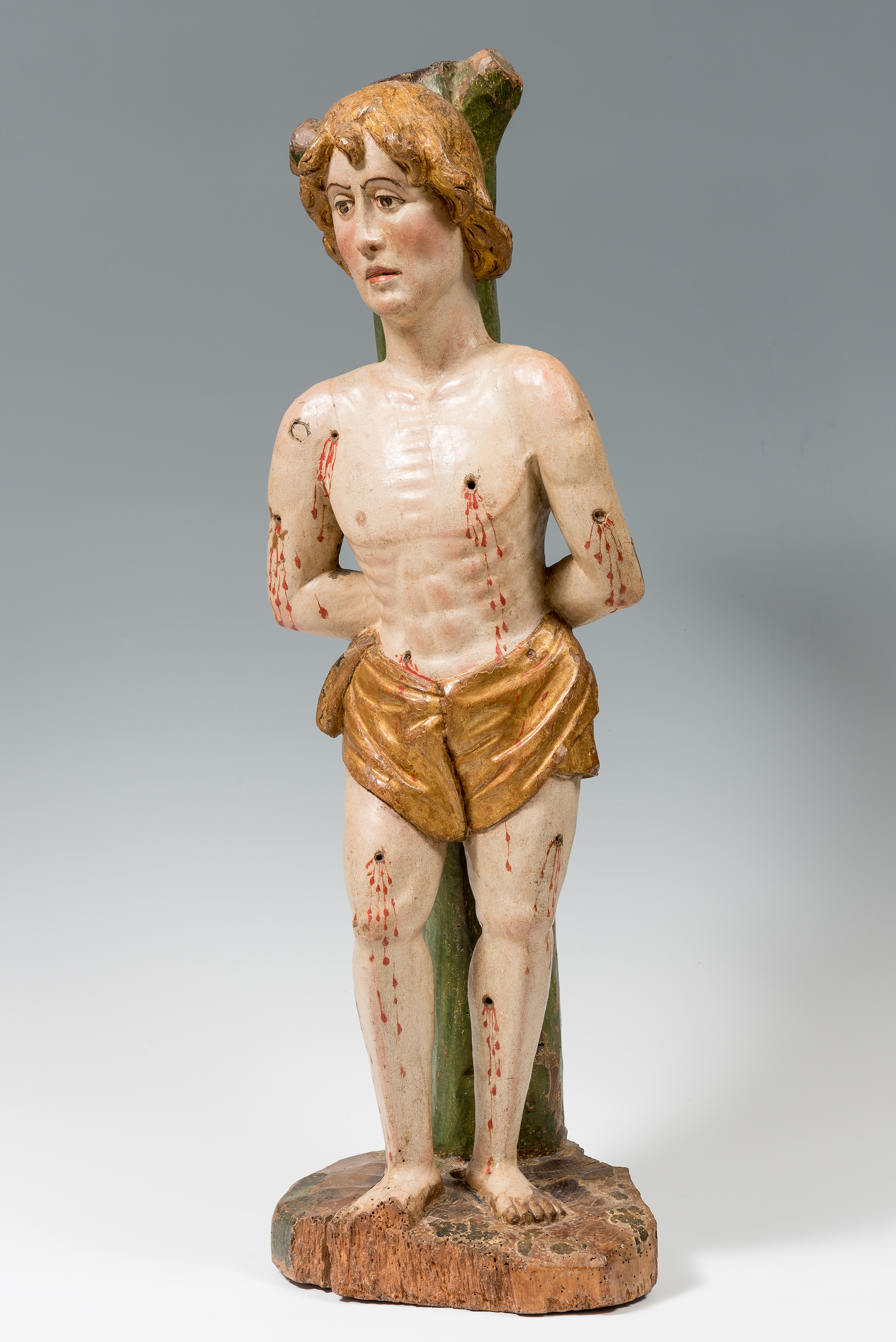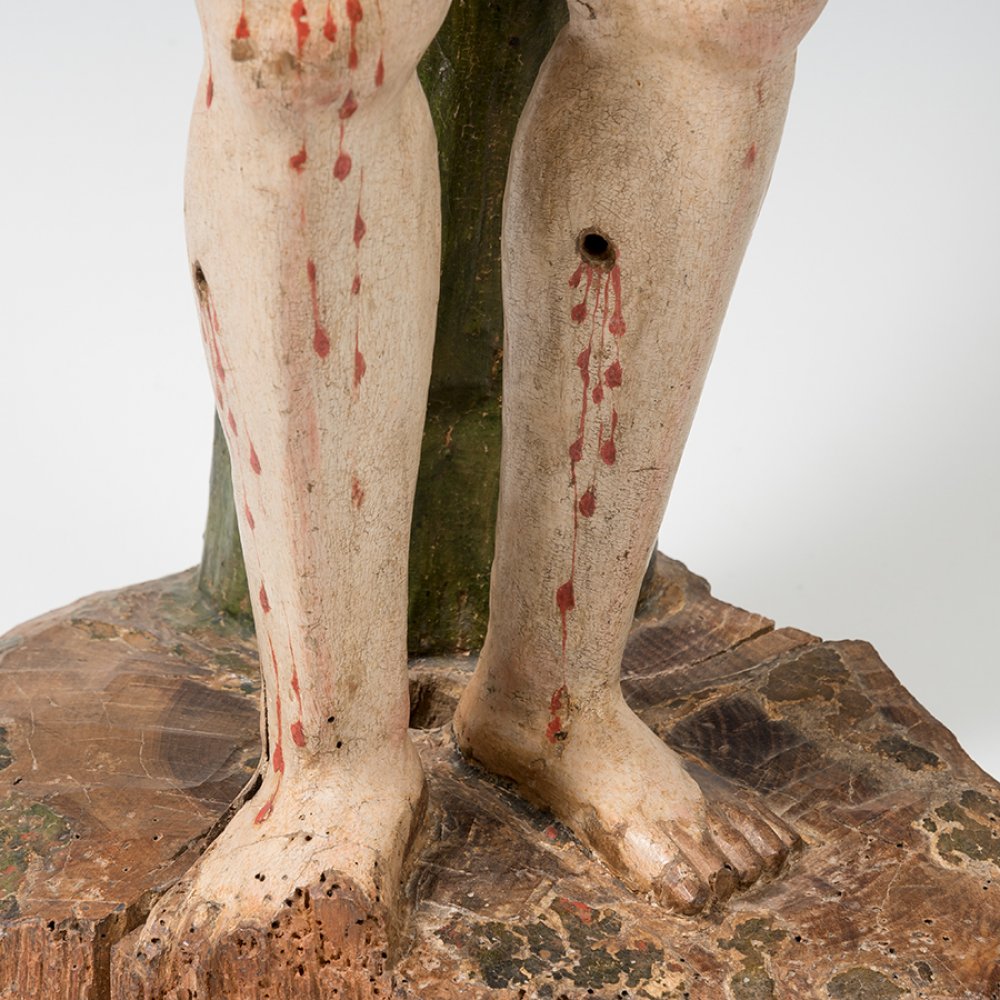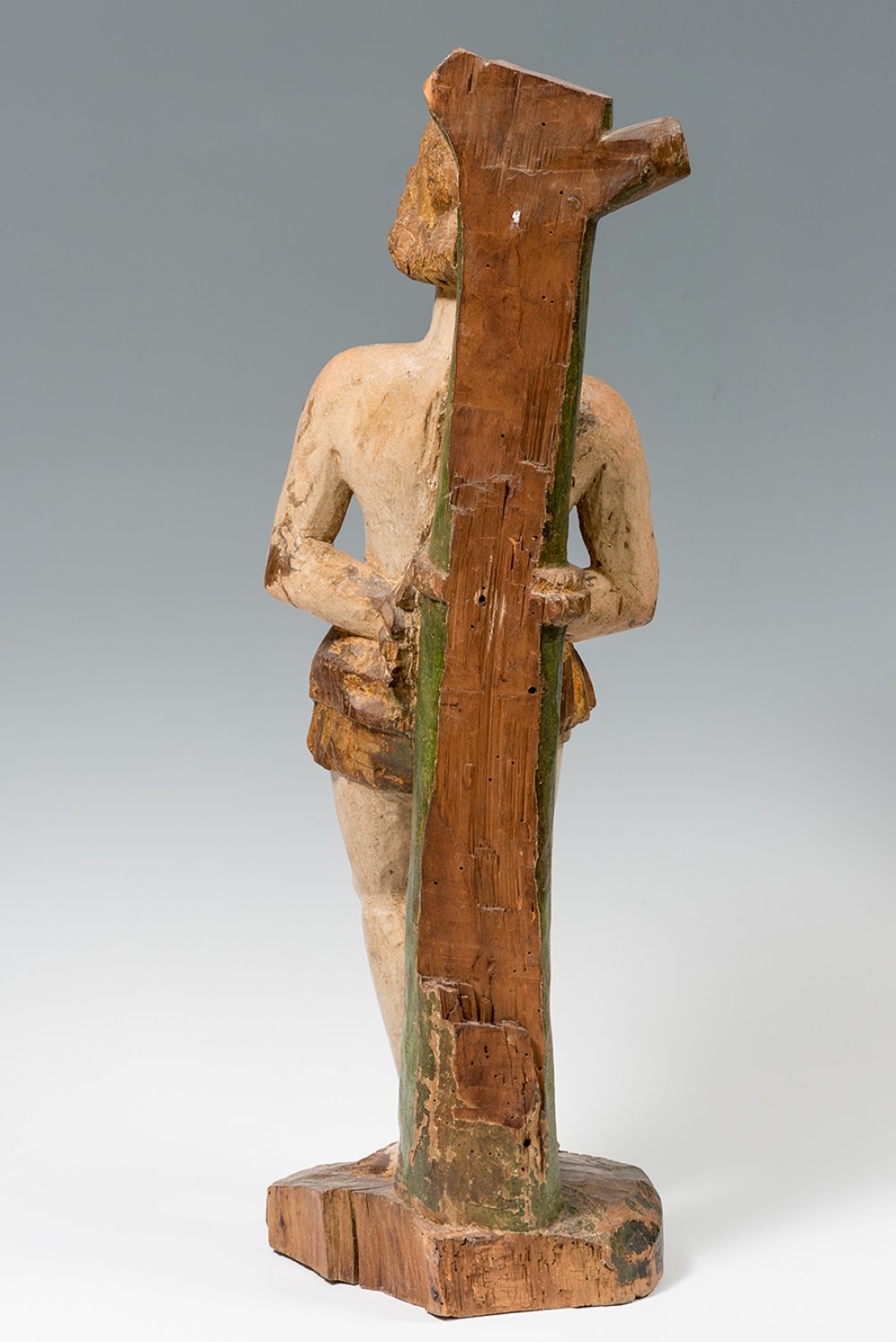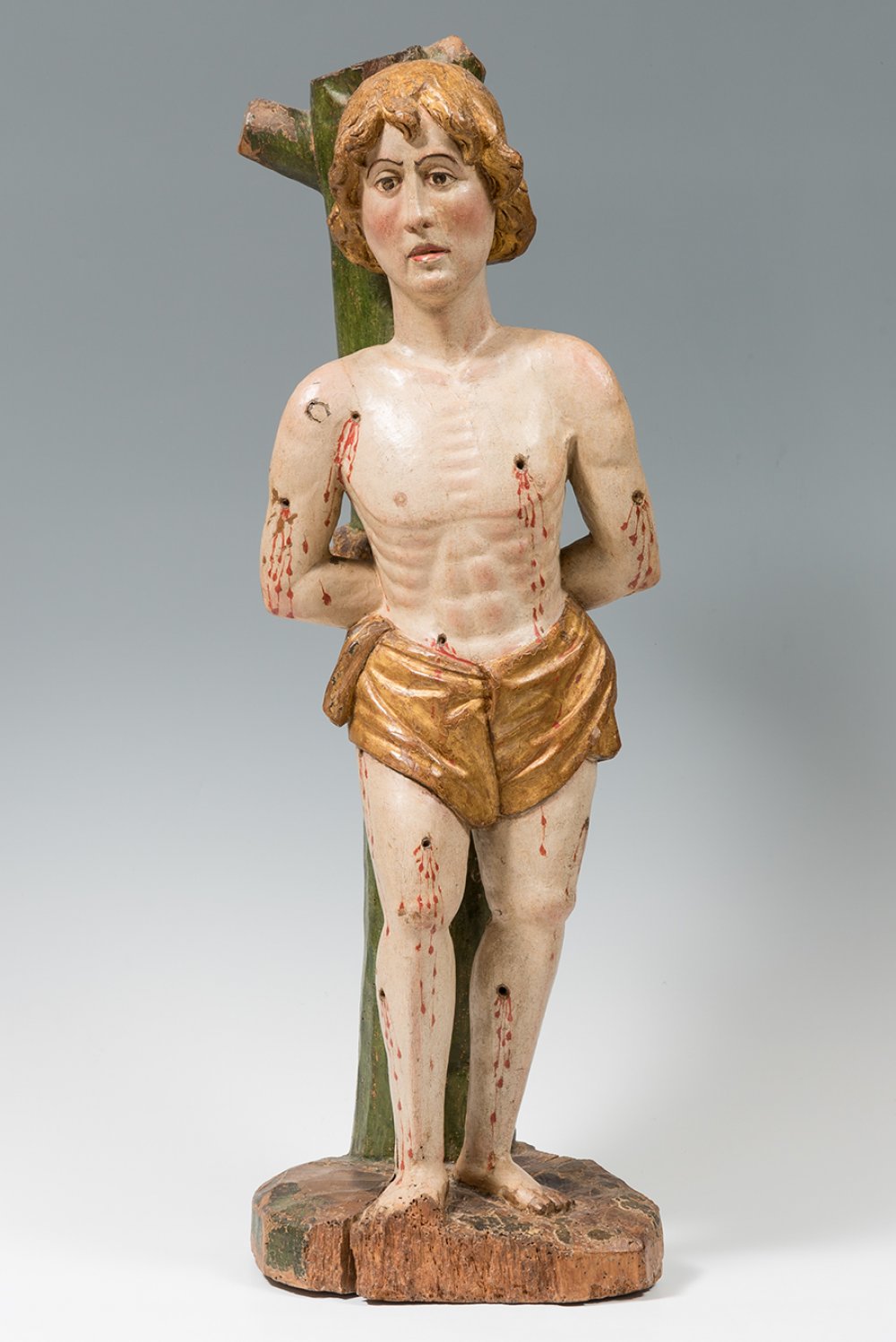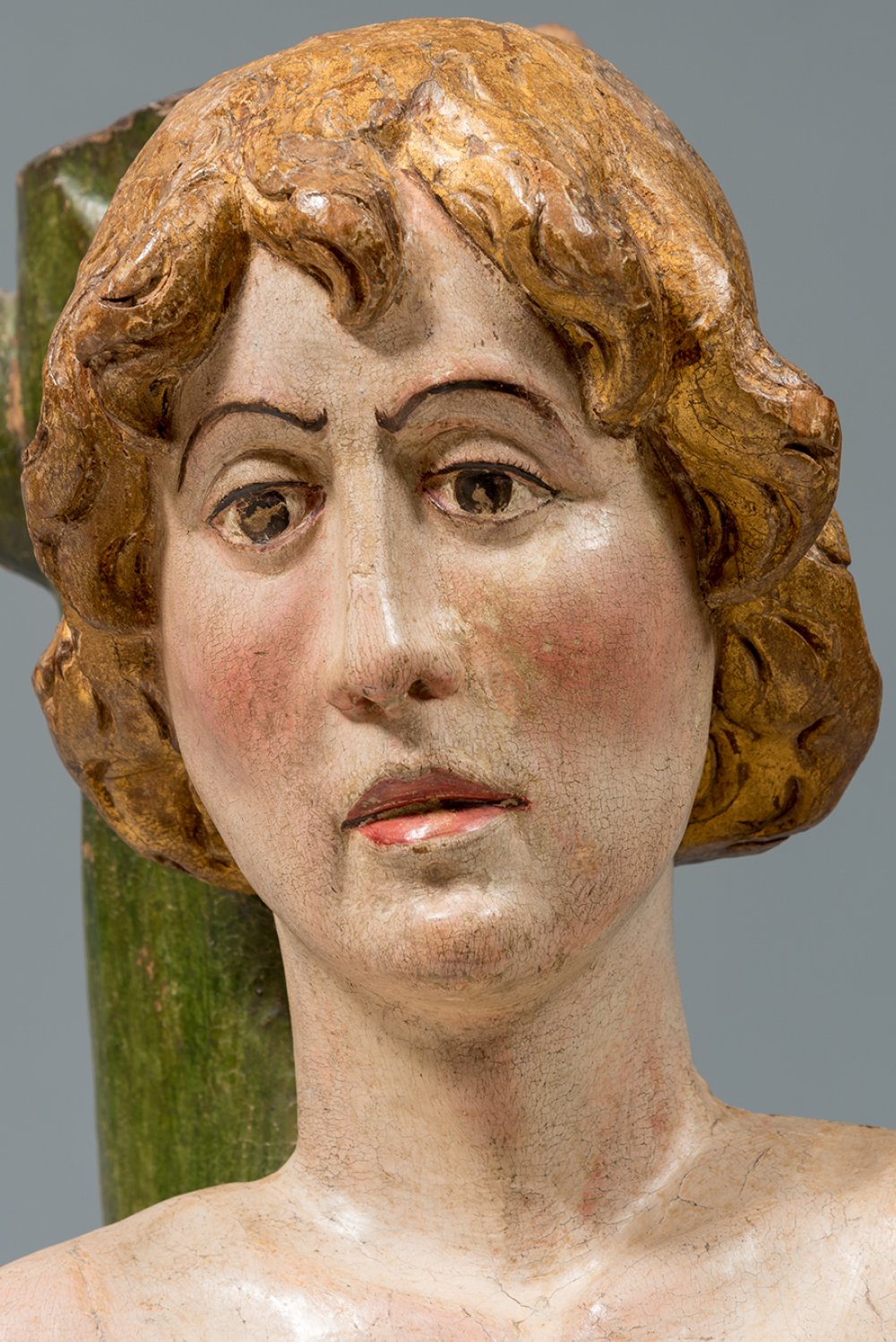6
South German school, ca. 1475."Saint Sebastian".Carved, polychromed and gilded wood.Measurements: 83
"Saint Sebastian".
Carved, polychromed and gilded wood.
Measurements: 83 x 27 x 21 cm.
Round figure carved in wood and polychrome, with a cloth of purity and golden hair, framed within the South German school and dated around 1475, at a time when the Gothic tradition of the end of the Middle Ages coexisted with the innovations that began to arrive from the Italian Renaissance. Thus we see an image still with symbolic conventions, such as the face, but already marked by an anatomical naturalism with classicist roots that is reflected in a less stylised proportion than in the Gothic style, in a more detailed work of anatomy and in a face that seeks to individualise the figure. The posture is also notable, with one leg in front of the other, following the models of classical statuary, replacing the feet together of medieval sculpture.
Germanic sculpture in the last century of the Gothic period left behind the short canon and the somewhat popular style through the influence of the innovative Dutch trend. This influence can be seen in the undulating or angular forms of the folds of the drapery, and in the delicate tenderness of certain female figures. The Virgin, like many saints, was now represented as a girl, both in the images of the Pietà and in those of the Virgin and Child in her arms. These representations acquired a very refined beauty in the Germanic school from the 1400s onwards, both in southern Germany and in Austria and Bohemia, as exemplified by the so-called "Beautiful Virgins" which spread as far as Poland and the Baltic lands. It was not until around 1430, however, that distinct schools of Germanic sculpture appeared, especially in the southern part of Germany, particularly in Bavaria (Nuremberg) and Swabia. The first important figure was Hans Multscher, an Austrian sculptor and painter born in Allgäu and settled around 1427 in Ulm, who initiated the Swabian school. Another exceptionally gifted master was to stamp a stamp of delicate idealism on Germanic sculpture immediately preceding that of the late Gothic. Nicolas Gerhaerts was Dutch by birth but worked in Germany and Austria. He executed works such as the Crucified Christ in the old cemetery in Baden-Baden (1467), a work that reveals very clearly how the artist had assimilated the influence of sculptural progressivism from both Flanders and Burgundy. He later moved to Vienna, where he carved a luxurious red marble tombstone of Emperor Frederick III in St. Stephen's Cathedral. Thanks to this sculptor and to skilful wood carvers such as Jórg Syrlin (author of the choir carvings in Ulm Cathedral), the maturity of German sculpture was established, which can be seen in numerous images and altars by the great sculptors of the last years of the 15th century and the first decades of the 16th century, already a reference point for the early Renaissance in the Germanic countries thanks to their new conception.
Born in Gaul and raised in Milan, Sebastian was a centurion of the first cohort in the time of the Emperor Diocletian (end of the 3rd - beginning of the 4th century). Denounced because he exhorted his friends Mark and Marcellinus to remain steadfast in their faith, by order of the emperor he was tied to a post in the centre of the Field of Mars, and served as a live target for the archers who shot him. But he did not die for it. The widow Irene, who wanted to raise his body for burial, noticed that he was still breathing, bandaged his wounds and saved his life. After he was cured, he reappeared before Diocletian to reproach him for his cruelty towards the Christians. He was then scourged, beaten to death in the circus and his corpse was thrown into the Maximian sewer. Shortly afterwards, Saint Sebastian appeared to Saint Lucila in her sleep to reveal to her the location of his remains, and asked her to bury him in the catacombs.
"Saint Sebastian".
Carved, polychromed and gilded wood.
Measurements: 83 x 27 x 21 cm.
Round figure carved in wood and polychrome, with a cloth of purity and golden hair, framed within the South German school and dated around 1475, at a time when the Gothic tradition of the end of the Middle Ages coexisted with the innovations that began to arrive from the Italian Renaissance. Thus we see an image still with symbolic conventions, such as the face, but already marked by an anatomical naturalism with classicist roots that is reflected in a less stylised proportion than in the Gothic style, in a more detailed work of anatomy and in a face that seeks to individualise the figure. The posture is also notable, with one leg in front of the other, following the models of classical statuary, replacing the feet together of medieval sculpture.
Germanic sculpture in the last century of the Gothic period left behind the short canon and the somewhat popular style through the influence of the innovative Dutch trend. This influence can be seen in the undulating or angular forms of the folds of the drapery, and in the delicate tenderness of certain female figures. The Virgin, like many saints, was now represented as a girl, both in the images of the Pietà and in those of the Virgin and Child in her arms. These representations acquired a very refined beauty in the Germanic school from the 1400s onwards, both in southern Germany and in Austria and Bohemia, as exemplified by the so-called "Beautiful Virgins" which spread as far as Poland and the Baltic lands. It was not until around 1430, however, that distinct schools of Germanic sculpture appeared, especially in the southern part of Germany, particularly in Bavaria (Nuremberg) and Swabia. The first important figure was Hans Multscher, an Austrian sculptor and painter born in Allgäu and settled around 1427 in Ulm, who initiated the Swabian school. Another exceptionally gifted master was to stamp a stamp of delicate idealism on Germanic sculpture immediately preceding that of the late Gothic. Nicolas Gerhaerts was Dutch by birth but worked in Germany and Austria. He executed works such as the Crucified Christ in the old cemetery in Baden-Baden (1467), a work that reveals very clearly how the artist had assimilated the influence of sculptural progressivism from both Flanders and Burgundy. He later moved to Vienna, where he carved a luxurious red marble tombstone of Emperor Frederick III in St. Stephen's Cathedral. Thanks to this sculptor and to skilful wood carvers such as Jórg Syrlin (author of the choir carvings in Ulm Cathedral), the maturity of German sculpture was established, which can be seen in numerous images and altars by the great sculptors of the last years of the 15th century and the first decades of the 16th century, already a reference point for the early Renaissance in the Germanic countries thanks to their new conception.
Born in Gaul and raised in Milan, Sebastian was a centurion of the first cohort in the time of the Emperor Diocletian (end of the 3rd - beginning of the 4th century). Denounced because he exhorted his friends Mark and Marcellinus to remain steadfast in their faith, by order of the emperor he was tied to a post in the centre of the Field of Mars, and served as a live target for the archers who shot him. But he did not die for it. The widow Irene, who wanted to raise his body for burial, noticed that he was still breathing, bandaged his wounds and saved his life. After he was cured, he reappeared before Diocletian to reproach him for his cruelty towards the Christians. He was then scourged, beaten to death in the circus and his corpse was thrown into the Maximian sewer. Shortly afterwards, Saint Sebastian appeared to Saint Lucila in her sleep to reveal to her the location of his remains, and asked her to bury him in the catacombs.
28th September - Old Masters
Sale Date(s)
Venue Address
General delivery information available from the auctioneer
Setdart offers Worldwide shipping
PICK UP IN ROOM: You can come and pick up your lots in our offices (Barcelona, Madrid or Valencia). At the moment of the withdrawal, you will be able to accept the current conditions of the lot by means of a document that you will sign.
YOU CAN SEND ANOTHER PERSON TO PICK UP: This person must present a signed authorization that you can find in our web page by accessing from BUY AT SETDART- LOGISTICS-DOWNLOAD AUTHORIZATION DOCUMENT. You can also send an e-mail with the requested data in AUTHORIZATION DOCUMENT to admin@setdart.com
Important Information
25% buyer´s premium
21% buyer´s premium at www.setdart.com
Terms & Conditions
The maximum period to pay the lots is 7 working days. You can pay either via bank transfer or with credit card through our platform www.setdart.com (we only accept VISA or Mastercard).
BUYER´S PREMIUM: 22% Hammer price + 21% VAT from the buyer´s premium
If your piece has more than 100 years, our Ministry of Culture requires an export certificate in order for the piece to leave the country. Note that if the piece goes inside the EU, there is no cost for the export certificate. If the piece goes outside the EU, there is a cost for the export certificate. You can find more information in our Ministry of Culture website: https://www.culturaydeporte.gob.es/en/cultura/patrimonio/exportacionimportacion/exportacion/tasas.html
INQUIRIES: admin@setdart.com
Setdart guides you through the entire process, from the time of award to the day you receive your lot. Our logistics team will be happy to manage your transport, and will advise you on the best shipping method with professionals from the sector used to handling works of art and jewelry.
WE OFFER WORLDWIDE DOOR TO DOOR SHIPPING
PICK UP IN ROOM: You can come and pick up your lots in our offices. At the moment of the withdrawal, you will be able to accept the current conditions of the lot by means of a document that you will sign.
YOU CAN SEND ANOTHER PERSON TO PICK UP: This person must present a signed authorization that you can find in our web page by accessing from BUY AT SETDART-LOGISTICS-DOWNLOAD AUTHORIZATION DOCUMENT. You can also send an e-mail with the requested data in AUTHORIZATION DOCUMENT to admin@setdart.com
SETDART IS NOT RESPONSIBLE FOR THE STATE OF THE PARTS ONCE THEY LEAVE OUR FACILITIES. MRW SHIPMENTS: Once the payment is made, your lot will be packed for shipment, the logistics department will send you an e-mail notifying you of the day it leaves our warehouse, changes of address cannot be made after receiving this e-mail.
INSURANCE INCIDENTS: Coverage for the value of the auction up to 3000 ? per shipment, if the value of the auction is higher, Setdart will send you a quote including the additional insurance. The insurance company WILL NOT BE RESPONSIBLE FOR THE SHIPMENT THAT EXCEEDS THAT AMOUNT AND IS NOT FULLY INSURED. MRW INCIDENTS: Maximum notification 48 hours after receipt, after which the insurance company WILL NOT BE RESPONSIBLE AND NO CLAIMS WILL BE ACCEPTED.
E-MAIL LOGISTICS: logistica@setdart.com
PICK UP YOUR MESSAGES: You can send your own messaging, prior notice via e-mail that your shipment is ready, please note 3 or 4 days in advance. This type of shipment is packaged so Setdart will provide you with a quote.
EXPENSES FOR STORAGE: We inform you that if the purchased lot is not picked up within a month, you will be charged 30€ per week per lot. Setdart Online S.L., owner of the web site "setdart.com", "setdart.net" and "setdart.org", acts as a company of Spanish nationality inscribed in the Volume 36955, sheet 182, page B-293056 of the Mercantile Registry, with registered office at Calle Aragó













